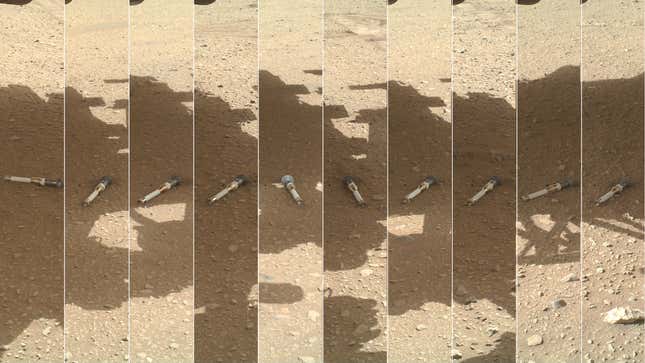Six California lawmakers wrote to NASA Administrator Bill Nelson last week to oppose the agency’s recent cuts to the Mars Sample Return mission, which aims to bring samples collected by the Perseverance rover on Mars to Earth.
The letter was written by congresspeople Judy Chu, Laphonza Butler, Mike Garcia, and Young Kim, as well as California senators Adam Schiff and Alex Padilla. In the letter, the six legislators described the NASA move as “short-sighted and misguided,” and claiming it “will cost hundreds of jobs and a decade of lost science.” You can read the letter in full here.
Advertisement
The lawmakers also cited the House appropriations bill that funds NASA, which states the following:
The Committee supports consistent funding for the Mars Sample Return mission. The Committee directs NASA to allocate no less than $949,300,000 for this mission. In accordance with the pending Independent Review Board’s results, and considering the existing architecture committed to successfully returning samples to Earth, the Committee directs NASA to ensure that its fiscal year 2025 budget request includes the funding necessary to complete the mission launch no later than 2030.
Advertisement
The Mars Sample Return (MSR) mission is the grand finale of Mars 2020, which launched Perseverance (and the spunky Ingenuity helicopter) to Mars in February 2021. Perseverance’s task is simple: investigate a region where a river delta flowed into a vast Martian lake several billion years ago. The rover has been collecting rock samples on its sojourns that scientists hope will address the key astrobiological question: whether life ever existed on another planet.
The Mars Sample Return requires a large suite of machinery: there are helicopters designed to recovery the samples collected by Perseverance, a launcher designed to get the samples into Mars orbit, a system to collect the orbiting samples, and of course the vehicles that will bring the samples to Earth orbit and down to its surface.
Advertisement

Perseverance completed its sample depot earlier this year. While the rover has played its part (mostly) without a hitch, the view from Earth is much more dire. In April, NASA set up a second review board to oversee the sample return to ensure it could be pulled off on time and under budget.
Advertisement
But the review board determined that the cost and timeline of the program was unrealistic, forcing NASA to reconsider how to get the precious Martian samples off that world and over to ours, a 31-million-mile trek. The program’s full lifecycle is now estimated to cost between $8 billion and $11 billion, a vastly larger price tag than the $4.4 billion the program was previously expected to cost, according to Ars Technica.
Earlier this month, the agency announced that it would be “ramping back” on MSR program work, citing the findings of the independent review board. In their letter to NASA Administrator Nelson, the California legislators said they were “mystified by NASA’s rash decision” to suggest cuts would be necessary before Congress finalized its appropriations process for the 2024 fiscal year. In the letter, the lawmakers stated that NASA’s funding moves violate Congress’s appropriations authority.
Advertisement
“If forced to operate at the unnecessarily low funding level prematurely directed by NASA in its November 8 letter, the Jet Propulsion Laboratory (JPL) will not be able to meet the 2030 launch window, billions of dollars in contracts supporting American businesses will be subject to cancellation, and hundreds of highly skilled jobs in California will be lost,” the lawmakers wrote. “This talent represents a national asset that we cannot afford to lose, and if this uniquely talented workforce is lost to the private sector, it will be near impossible to reassemble.”
Launch windows to Mars occur roughly every 26 months, and it would be costly to miss the timeline currently charted for the Mars mission. How NASA proceeds will define the timeline of human exploration off Earth—and our insight into Mars’ ancient past—for the next decade.
Advertisement
More: Is NASA Done Sending Traditional Rovers to Mars?
Services Marketplace – Listings, Bookings & Reviews